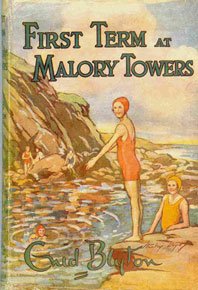 MALORY TOWERS
MALORY TOWERS
Enid Blyton
First published 1946
I was in primary school when I was given the set of Malory Towers books as a birthday gift. I’d read a lot of Blyton before then, as my mother was a baby boomer; so I had grown up with the 1950s copies of the Five Find Outers and Dog series, The Famous Five, The Secret Seven, etc.
Malroy Towers is by far my favorite series she wrote.
To me, as an adult who often rereads childhood favorites, I can categorize Enid Blyton into three classes.
The first is the younger children’s books, which are often short stories – eg Josie, Click and Bun, or Billy Bob, or the Faraway Tree. Every story has a moral or ethical stance but the amusement factor of the story is the priority. They are full of plot, very short and sweet.
The second category are the books that only work on one level – the adventure series that are often very shallow in character development, but full of plot. It’s all about stolen necklaces and smugglers hiding in caves and a group of children on their Hols solving some sort of mystery. They can be fun, they are targeted to slightly older children. The Secret Seven and Famous Five are kind of unreadable as an adult due to the repetitiveness and the lack of character development. I struggle to work out why I liked certain books and why I read certain scenes over time and again.
Then there are the final group of books – the ones I would consider to be her good novels, with characters that are fully fleshed out and which are entertaining enough to read often even as an adult. She did these in stand alone books (eg, The House at the Corner) or in series – Malory Towers and St Clares.
Malroy Towers, based on an internet search I just did, does not appear to be out of print since first published in 1946. Lately it appears to have been rebranded with very modern covers to appeal to kids today. That’s a lot of people out there who agree that it’s a worthwhile set of books. But why?
Well because the characters are likeable girls/teachers with well defined personalities and the stories are timeless. Each book focuses on a chosen few main themes/problem characters. As the school year goes on, the issues are resolved. (I often consider the Harry Potter books to be based on this structure too!) It’s extraordinarily humanistic and well considered writing. I also will note that the girls don’t discuss boys and not a single one of the girls plans to find a husband after finishing school – they all want some form of career and they go out and seek it. For the time she was writing, that’s fairly impressive.
Plus the stories are pacey and rollicking and interesting. Like Rowling does later with Potter, Blyton really makes sure there is the correct amount of justice metered out to the characters deserving of such justice; everyone gets their just deserts. Characters who are not decent to start with (shallow, vain, bullies, thieves, lazy, obsessed) get offered a chance to choose a different path – and mostly they take it, and are rewarded. The girls are pushed to become intelligent, thinking, independent, honorable, caring women. That’s the point of the school. The headmistress makes a speech to all new girls pointing out their successes are not about academic success, but whether you come out as a decent all rounded kind person. This is an ethical stance I agree with.
The books were set in post war England during the time of food rationing. One thing I think it can take some time to understand is that the endless descriptions of delicious meals in all Blyton’s books (Sardines! Tomatoes! Ginger Pop! Butter! Cream! Roast Chicken! Ices! Cake! Biscuits!) that are so mocked in Five go Mad in Dorset were a bit of a wish list of the sorts of foods they were not getting enough of at the time; food rationing went well into the 1950s. Her descriptions of meals are often seemingly endless. Hey, bring it on. Food is awesome. Your mouth waters at the descriptions of the Teas and dinners and midnight feasts that are described.
It’s hard to talk about Blyton without a mention of her attitude to class. She’s very non-modern and it can really jar with modern sensibilities. She was born in the Edwardian era and saw two world wars, she was a middle class English woman who clearly had a cook and some maids and a gardener; you have to read these books knowing they are of their time. There is one character, Gwendoline, who sucks up to anyone who has a social standing higher than her own, for example. The Malory Towers books are steeped in these class ethics and attitudes – but because they are set in a school there is not a lot of interaction with other classes and so it’s not as obvious as some of her other books. Possibly this is another reason they’ve stayed in print, they are inoffensive.
For example there is a book of hers called ‘The Put-em Rights’ which focuses on a gang of children in a village who decide to Put Things Right. This includes going to poor people’s houses and instructing them on Hygiene and how to wash their babies…. And one of the children finds out his father is in jail, not in the army at all, and thus he resigned from the group because that means he’s no better than a poor child. Now, this stuff is unreadable these days, it’s cringe-worthy – but there is not really any of that sort of thing in Malory Towers!
In summation – yeah, I love Enid Blyton, go read this series!

